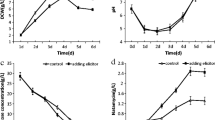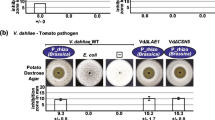Abstract
Two Fusarium graminearum strains were cultured in glucose yeast extract peptone broth or minimal medium broth to measure the production of mycelial biomass, pH, mycotoxins, and aurofusarin pigment, when limited to single carbon sources (at 1%), including xylan, cellulose, starch, or glucose. A random complete block design with factorial arrangement and analysis of variance at a significance level of 0.01 were employed to test for treatment differences. Overall, the F. graminearum strains produced significantly more biomass, deoxynivalenol, and aurofusarin with xylan than with cellulose. No significant differences were found in terms of 15–acetyldeoxynivalenol production from the four carbon sources. The presence of significant interactions between the strains, carbon sources, and media led to the following specific differences. In yeast extract peptone broth, R-9828 strain yielded significantly more deoxynivalenol production with xylan than cellulose and R-9832 produced significantly more mycelium (biomass) with xylan than cellulose. R-9828 strain yielded significantly more deoxynivalenol production than the R-9832 strain. Also in yeast extract peptone broth, cellulose led to significantly higher pH values than other carbons, which might be due to the limited ability of the Fusarium strains to utilize cellulose as an energy source. Aurofusarin was the only expressed analyte to show a significant difference in minimal medium broth, and R-9832 produced significantly more aurofusarin with xylan than with cellulose in the broth. These results suggest that xylan may induce Fusarium growth and deoxynivalenol production to assist the infection process and may support the theory that F. graminearum invades through xylan in the cell walls of cereals.





Similar content being viewed by others
Abbreviations
- ANOVA:
-
Analysis of Variance
- AU:
-
Absorbance Unit
- 3-ADON:
-
3-acetyldexynivalenol
- 15-ADON:
-
5-acetyldeoxynivalenol
- CMC:
-
carboxymethycellulose
- CLA:
-
carnation leaf agar
- DON:
-
deoxynivalenol
- FHB:
-
Fusarium head blight
- GYEP:
-
glucose yeast extract peptone broth
- HPLC:
-
high performance liquid chromatography
- MM:
-
Minimal medium broth
- NIV:
-
nivalenol
- PDA:
-
photodiode array detector
- RCBD:
-
random complete block design
- ZEN:
-
zeralenone
References
Bell, A. A., Wheeler, M. H., Liu, J. G., & Stipanovic, R. D. (2003). United States Department of Agriculture—Agricultural Research Service studies on polyketide toxins of Fusarium oxysporum f sp vasinfectum: potential targets for disease control. Pest Management Science, 59, 736–747.
Bily, A. C., Reid, L. M., Savard, M. E., Reddy, R., & Blackwell, B. A. (2004). Analysis of Fusarium graminearum mycotoxins in different biological matrices by LC/MS. Mycopathologia, 157, 117–126.
Booth, C. (1971). The genus Fusarium. Surrey: Commonwealth Mycological Institute.
Buchenauer, H., & Kang, Z. (2004). Ultrastructural studies on infection process of Fusarium Head Blight in resistant and susceptible wheat genotypes. Paper presented at the 2nd International Symposium on Fusarium Head Blight Incorporating the 8th European Fusarium Seminar, Orlando, Florida, December.
Burkhead, K. D. (1990). Production, characterization, and biogenesis of aurofusarin from a new strain of Fusarium graminearum. Dissertation, University of Iowa.
Bushnell, W. R., Hazen, B. E., & Pritsch, C. (2003). Histology and physiology of Fusarium head blight. In K. J. Leonard & W. R. Bushnell (Eds.), Fusarium head blight of wheat and barley (pp. 44–83). Minnesota: The American Phytopathological Society.
Carpita, N. C., Defernez, M., Findlay, K., Wells, B., Shoue, D. A., Catchpole, G., et al. (2001). Cell wall architecture of the elongating maize coleoptile. Plant Physiology, 127, 551–565.
Gardiner, D. M., Kazan, K., & Manners, J. M. (2009). Nutrient profiling reveals potent inducers of trichothecene biosynthesis in Fusarium graminearum. Fungal Genetics and Biology, 46, 604–613.
Giesbrecht, F. G., & Gumpertz, M. L. (2004). Planning, construction, and statistical analysis of comparative experiments. Hoboken, New Jersey: Wiley.
Goswami, R. S., & Kistler, H. C. (2004). Heading for disaster: Fusarium graminearum on cereal crops. Molecular Plant Pathology, 5, 515–525.
Grabber, J. H., Ralph, J., Lapierre, C., & Barriere, Y. (2004). Genetic and molecular basis of grass cell-wall degradability. I. Lignin-cell wall matrix interactions. Plant Biology and Pathology, 327, 455–465.
Hellweg, M. (2003). Molecular, biological and biochemical studies of proteolytic enzymes of the cereal pathogen F. graminearum, Inaugural Dissertation, Retrieved September 21, 2006, from www.deposit.ddb.de.
Hinkelmann, K. (2004). Evaluation and interpreting interactions. Technical Report number 04–5. Retrieved November 1, 2006, from Virginia Polytechnic Institute and State University, Department of Statistics Web site: www.stat.org.vt.edu/dept/web-e/tech_reports/TechReport04-6.pdf.
Izydorczyk, M. S., & Biliaderis, C. G. (1995). Cereal arabinoxulans: advances in structure and physicochemical properties. Carbohydrate Polymers, 28, 33–48.
Izydorczyk, M. S., & MacGregor, A. W. (2000). Evidence of intermolecular interactions of β-glucans and arabinoxylans. Carbohydrate Polymers, 41, 417–420.
Jansen, C., von Wettstein, D., Schafer, W., Kogel, K. H., Felk, A., & Maier, F. J. (2005). Infection patterns in barley and wheat spikes inoculated with wild-type and trichodiene synthase gene disrupted Fusarium graminearum. Proceedings of the National Academy of Sciences of The United States of America, 102,16892–16897.
Jiao, F., Kawakami, A., & Nakajima, T. (2008). Effects of different carbon sources on trichothecene production and Tri gene expression by Fusarium graminearum in liquid culture. FEMS Microbiology Letters, 285, 212–219.
Kang, Z., & Buchenauer, H. (1999). Immunocytochemical localization of fusarium toxins in infected wheat spikes by Fusarium culmorum. Physiological and Molecular Plant Pathology, 55, 275–288.
Kang, Z., & Buchenauer, H. (2000). Ultrastructural and cytochemical studies on cellulose, xylan and pectin degradation in wheat spikes infected by Fusarium culmorum. Journal of Phytopathology, 148, 263–275.
Kang, Z., Zingen-Sell, I., & Buchenauer, H. (2005). Infection of wheat spikes by Fusarium avenaceum and alterations of cell wall components in the infected tissue. European Journal of Plant Pathology, 111, 18–28.
Leschine, S. B. (1995). Cellulose degradation in anaerobic environments. Annual Reviews of Microbiology, 49, 399–426.
Lysoe, E., Klemsdal, S. S., Bone, K. R., Frandsen, R. J. N., Johansen, T., Thrane, U., et al. (2006). The PKS4 gene of Fusarium graminearum is essential for zearalenone production. Applied and Environmental Microbiology, 72, 3924–3932.
McCormick, S. (2003). The role of DON in pathogenicity. In K. J. Leonard & W. R. Bushnell (Eds.), Fusarium head blight of wheat and barley (pp. 165–184). St. Paul, Minnesota: The American Phytopathological Society.
Medentsev, A. G., Kotik, A. N., Trufanova, V. A., & Akimenko, V. K. (1993). Identification of an aurofusarin from Fusarium graminearum that causes egg quality deterioration in hens. Applied Biochemistry and Microbiology, 29, 406–409.
Miller, J. D., & Greenhalgh, R. (1985). Nutrient effects on the biosynthesis of trichothecenes and other metabolites by Fusarium graminearum. Mycologia, 77, 130–136.
O’Donnell, K., Kistler, H. C., Tacke, B. K., & Casper, H. H. (2000). Gene genealogies reveal global phylogeographic structure and reproductive isolation among lineages of Fusarium graminearum, the fungus causing wheat scab. Proceedings of the National Academy of Sciences of the United States of America, 97, 7905–7910.
Oshima,T. C., & McCarty, F. (2006). Factorial Analysis of Variance Statistically significant interactions: what’s the next step? Retrieved September 2006 1 from Georgia State University web site: www.gsu.edu/∼epstco/aeraStudent.pdf.
Pestka, J. J., Bahrawy, A., & Hart, L. P. (1985). Deoxynivalenol and 15-monoacetyl deoxynivalenol production by Fusarium graminearum R6576 in liquid media. Mycopathologia, 91, 23–28.
Proctor, R. H., Desjardins, A. E., McCormick, S. P., Plattner, R. D., Alexander, N. J., & Brown, D. W. (2002). Genetic analysis of the role of trichothecene and fumonisin mycotoxins in the virulence of Fsarium. European Journal of Plant Pathology, 108, 691–698.
Schwarz, P. B., Schwarz, J. G., Zhou, A., Prom, L. K., & Steffenson, B. J. (2001). Effect of Fusarium graminearum and F. poae infection on barley and malt quality. Monatsschrift für Brauwissenschaft, 54, 55–63.
Schwarz, P. B., Jones, B. L., & Steffenson, B. J. (2002). Enzymes associated with Fusarium infection of barley. Journal of the American Society of Brewing Chemists, 60, 130–134.
Shibata, S., Morishita, E., Takeda, T., & Sakata, K. (1968). Metabolic products of fungi. XXVIII. The structure of anrofusarin. Chemistry and Pharmaceutical Bulletin, 16, 405–410.
Siranidou, E., Kang, Z., & Buchenauer, H. (2002). Studies on symptom development, phenolic compounds and morphological defense responses in wheat cultivars differing in resistance to Fusarium head blight. Journal of Phytopathology, 150, 200–208.
Stergiopoulos, L., Zwiers, L., & Maarten, A. (2002). Secretion of natural and synthetic toxic compounds from filamentous fungi by membrane transporters of the ATP-binding casete and major facilitator superfamily. European Journal of Plant Pathology, 108, 719–734.
Voigt, C. A., Scheidt, B. V., Gacser, A., Kassner, H., Lieberei, R., Schafer, W., et al. (2007). Enhanced mycotoxin production of a lipase-deficient Fusarium graminearum mutant correlates to toxin-related gene expression. European Journal of Plant Pathology, 117, 1–12.
Wolf-Hall, C. E., & Bullerman, L. B. (1998). Characterization of Fusarium graminearum strains from corn and wheat by deoxynivalenol production and RAPD. Journal of Food Mycology, 1, 171–180.
Author information
Authors and Affiliations
Corresponding author
Rights and permissions
About this article
Cite this article
Zhang, H., Wolf-Hall, C. The effect of different carbon sources on phenotypic expression by Fusarium graminearum strains. Eur J Plant Pathol 127, 137–148 (2010). https://doi.org/10.1007/s10658-010-9578-0
Accepted:
Published:
Issue Date:
DOI: https://doi.org/10.1007/s10658-010-9578-0




